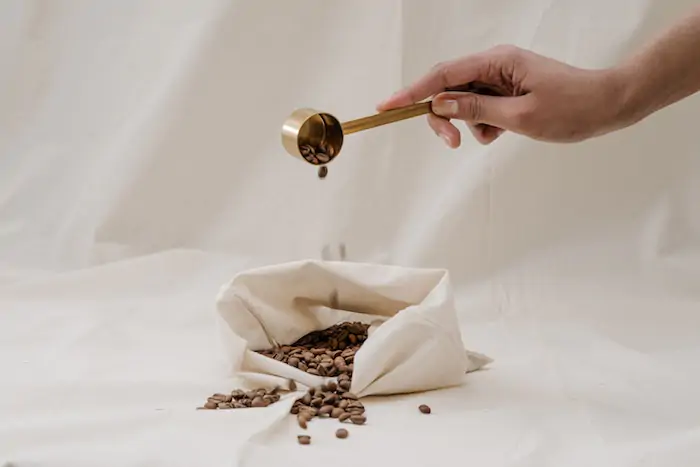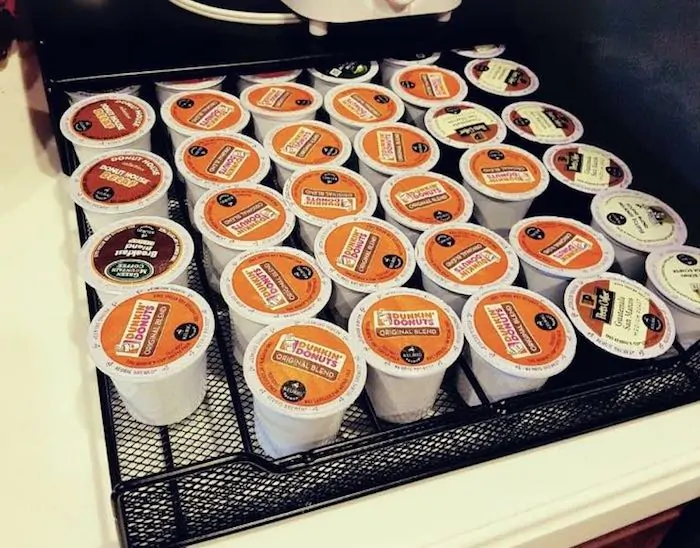No more wondering about the exact coffee measurements behind the perfect cup of coffee, with the use of a coffee scoop. But how big is a coffee scoop? Read on to find out more.

The perfect cup of Joe comes down to the right measurement of coffee grounds; however, what this quantity is or how to ensure this amount can be confusing without the right tool. Even when referring to the coffee package, which provides you with a standard recipe, it can leave you guessing as to how to achieve the recommended amount of coffee grounds.
For this reason, many people use a coffee scoop to measure their coffee grounds, but just how big is a coffee scoop? The size of your coffee cup scoop will ultimately determine how strong or weak coffee you prefer. However, the standard coffee scoop size is two tablespoons (.36 ounces or 10 grams), which you can use as a starting point.
The Coffee Scoop Explained
Scoops come in all different shapes, sizes, and styles, which can make deciding which to use for measuring your coffee grounds quite bewildering.
However, there is a standard coffee scoop size, which equals two tablespoons (0.36 ounces or 10 grams). This standard scoop size is based on the standard coffee recipe, which recommends using two tablespoons of coffee grounds per serving.
If you are unsure if your coffee scoop is the equivalent of two tablespoons, you can test it using a bit of liquid, such as water. To do so, fill a regular tablespoon with liquid and then empty it into your coffee scoop. Fill the tablespoon with liquid a second time and then empty it into the scoop.
If the liquid fills the scoop, then the scoop is a standard coffee scoop size, and you are good to go. If not, you can still use the smaller scoop to measure your coffee grounds; however, you will need to adjust the measurement so that it equals two tablespoons. Or you can go out and purchase a two tablespoon-size scoop.
Making Coffee Using The Standard Coffee Scoop
The main question is how much in a coffee scoop? The standard coffee recipe calls for using two tablespoons of coffee grounds to make a serving of coffee; however, for some people, this standard measurement can result in a coffee that is too robust or too watered down, depending on the size of the drinking container as well as how much of a caffeine kick you prefer.
Therefore, you may have to play around with the standard recipe until you find the right coffee ratio for you.
The size of your coffee grounds will also determine the amount of coffee in your scoop, which will also affect the coffee strength. For instance, since fine ground coffee contains smaller particles, it results in more coffee in the scoop, which will also yield a stronger tasting coffee.
On the other hand, coarse ground coffee contains larger particles; therefore, it takes fewer grounds to fill the same size scoop, which will, in turn, also result in a weaker flavored coffee.
You should also keep in mind that some coffee makers, such as drip coffee makers, produce enough coffee to fill more than just a single cup. Therefore, if you are making multiple cups of coffee, you will need to add two tablespoons of ground coffee per cup, or it will also result in a weaker coffee.
For instance, if your coffee maker produces up to 12 cups of coffee, and you would like to use its full extent, then you would need 24 tablespoons of coffee, or 12 standard coffee scoops, to produce one 12 cup serving of coffee that imparts the same flavor in every cup.
Otherwise, simply fill the water reservoir just to the 8-ounce level and stick with the standard coffee scoop amount. You might also be wondering, is a coffee scoop equal to one tablespoon?

Some single-serve coffee makers also use the standard two-tablespoon servings for their coffee pods or K-cups; however, their water measurement is usually only for a 6-ounce cup, so keep this mind because it will result in a stronger coffee.
At the same time, other single-serve coffee makers may use a smaller coffee scoop per 6-ounce cup or larger, while others may use a larger serving of water per standard coffee scoop, which will also affect the outcome of your coffee.
Many times, coffee that comes in a tin will also include a coffee scoop; however, usually, this scoop only equals one tablespoon. So if you purchase a coffee that includes its own scoop, just be sure to test it first to ensure it equals 2 tablespoons.
If you are using a different brewing method, such as the French Press method, it will also determine the amount of coffee or the coffee scoop size you use because since a French Press often calls for a more coarse ground, you will need to use more coffee to produce a good cup of coffee.
Likewise, if you are using an espresso machine, which calls for using finer grounds, you may require a smaller coffee scoop, unless you are making a double shot of espresso, in which case, the standard two tablespoon coffee scoop is fine.
Once you find the exact coffee scoop size for your perfect cup of coffee, you may consider just leaving it in the coffee container for easy access and an accurate measurement each time you make coffee. Or you can set it aside along with all your other accessories in your coffee station, where it can serve as your designated coffee scoop.
When using the standard two tablespoon coffee scoop measurement, or any other coffee scoop, the scoop should be filled to the brim with coffee and then leveled to ensure the proper measurement.
Getting The Water To Standard Coffee Scoop Ratio Right
Getting the right coffee to water ratio using the standard coffee scoop size can be difficult if you don’t know your coffee cup size, which will ultimately determine the water amount.
In fact, when many people reach for their one-handled cup, they are unaware if it is a coffee cup or a coffee mug. However, knowing whether your drinking vessel is a coffee cup or a coffee mug matters because they differ in size, which can cause your measurement to be off when following the standard coffee recipe, which typically calls for either an 8-ounce or a 6-ounce cup.
A standard coffee cup is only 6 fluid ounces, and it is also typically used to serve tea. On the other hand, a standard coffee mug is 8 fluid ounces, and it is also most often used to serve heartier hot drinks, such as soup and hot chocolate.
Some people also prefer a travel mug to enjoy their coffee, which keeps your coffee hot longer and can be easily carried with you; however, because they are even bigger, ranging between 15 to 20 ounces, it can throw the standard recipe off. Therefore, be sure to adjust the measurements based on your cup size.
In the end, no matter your preferred coffee receptacle, just be sure you know what size it is, which will help ensure the right coffee-to-water ratio for the perfect cup of Joe every time.
FAQs On How Much In A Coffee Scoop
Where Can I Find a Coffee Scoop?
Coffee scoops are essentially the same thing as standard measuring spoons. This means you can use a simple measuring spoon from your own kitchen stash to measure your coffee, or you can buy a designated coffee scoop from your favorite home goods store.
Coffee scoops are most commonly made from plastic or stainless steel; however, there are some made of bamboo and some made of ceramic, and they also range in handle type from short to long, which makes it easier to reach the coffee.
Are There Other Ways to Measure the Standard Coffee Amount Without Using a Scoop?
If you do not have a two-tablespoon coffee scoop, there are other ways to ensure this measurement using other methods and tools. For instance, if you have a tablespoon, you can just fill the tablespoon twice with coffee grounds and then add it to your 6 or 8-ounce cup for the standard measurement.
Some people also use a digital kitchen scale like this to measure their coffee grounds only, instead of measuring for the two tablespoon measurement, you will look for an equivalent weight of two tablespoons, which is 0.36 or 10 grams. You can also use your scale to measure out the perfect water ratio.
To measure your coffee grounds using a digital scale, place a cup or other container on the scale, and then slowly add the coffee grounds to the cup until the scale reads 10 grams or 0.36 ounces. To measure your water, fill the cup with water until the scale reads 6 fluid ounces or 180 ml.
You can also use your grinder to measure two tablespoons of coffee grounds, only this will rely more on the eyeballing method, at first. To do so, place what looks like will yield two tablespoons of ground coffee, in whole coffee beans, into the grinder, and then once the coffee is ground, measure out two tablespoons.
If the amount of coffee beans you ground equals two tablespoons of ground coffee, then you will be able to pretty much eyeball the correct amount of coffee grounds each brew. If not, adjust the number of whole coffee beans in the grinder until it yields two tablespoons of ground coffee, after which time, you can eyeball the correct amount of coffee per cup.
Can I Use the Standard Coffee Scoop to Measure Two Tablespoons of Whole Coffee Beans?
Similar to coarsely ground coffee, whole beans are much larger, which means it will require fewer beans to fill a two tablespoon-size coffee scoop, which can result in a weaker coffee once it is ground and brewed.
Therefore, when measuring whole coffee beans using the standard two-tablespoon recipe, you will need to add a few more coffee beans to the scoop to adjust for their size. This way, once the beans are finely ground, the ground coffee will equal two tablespoons.
Or you could place a small container on a digital scale and then keep adding the whole beans until their weight equals 10 grams, which should yield two tablespoons of ground coffee.
